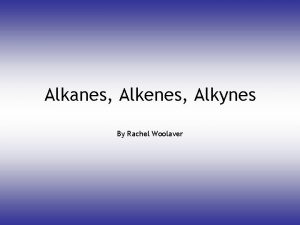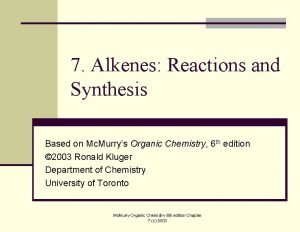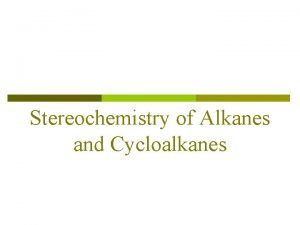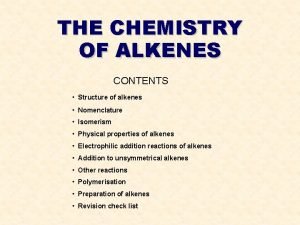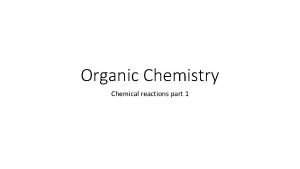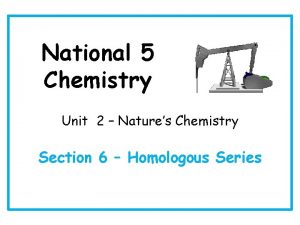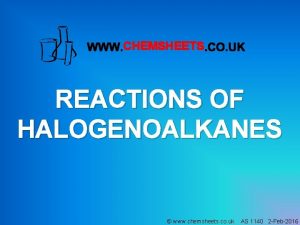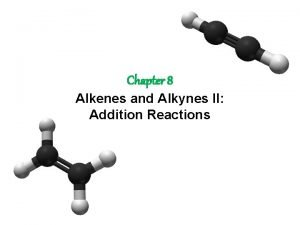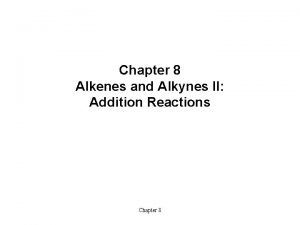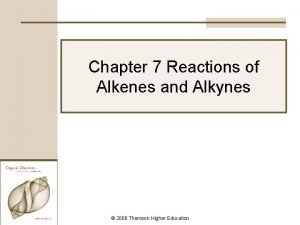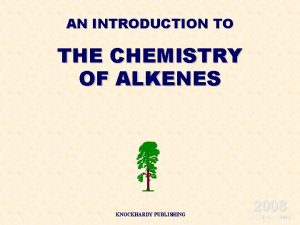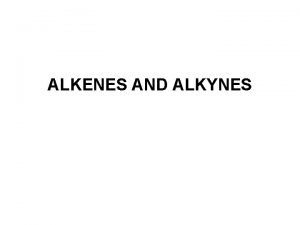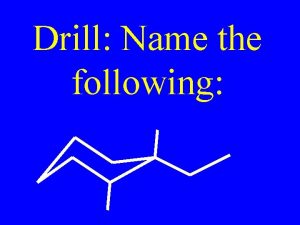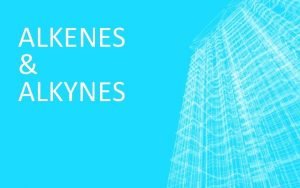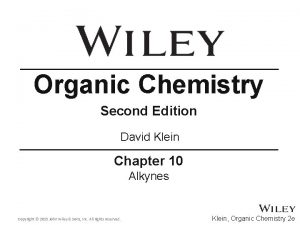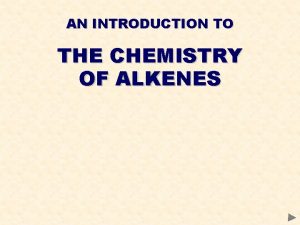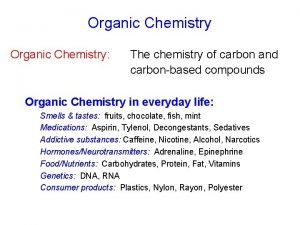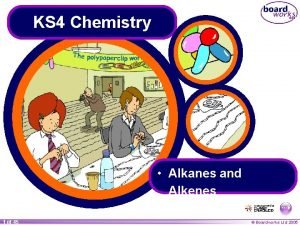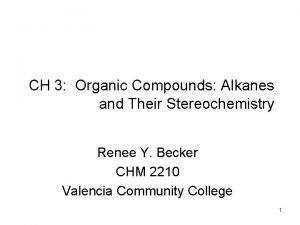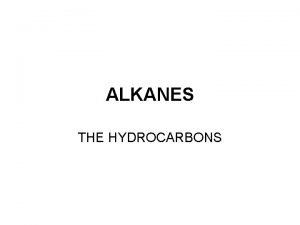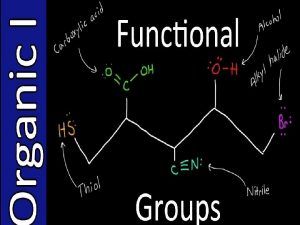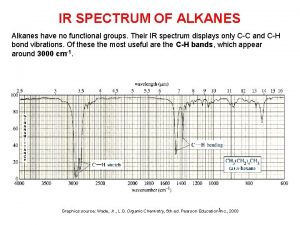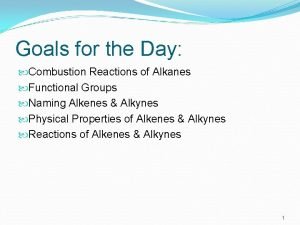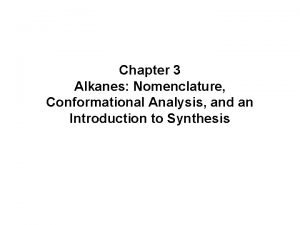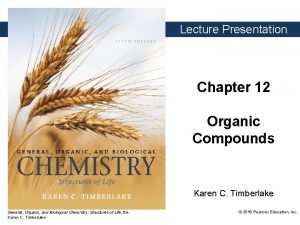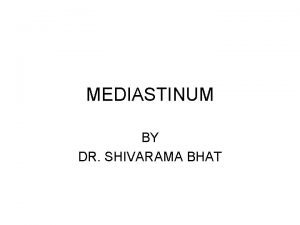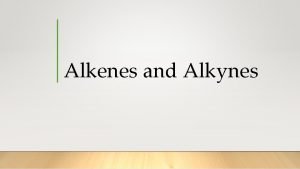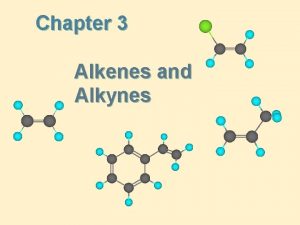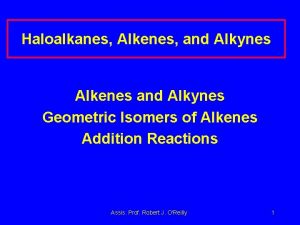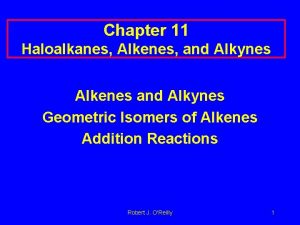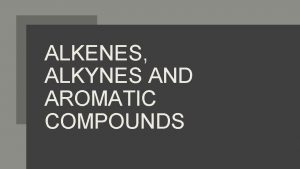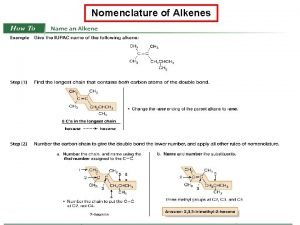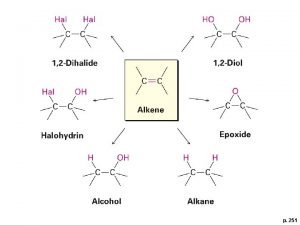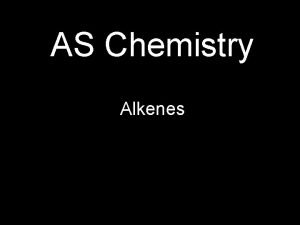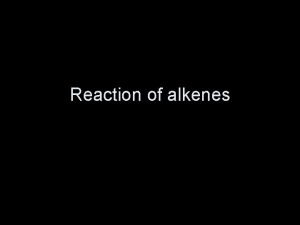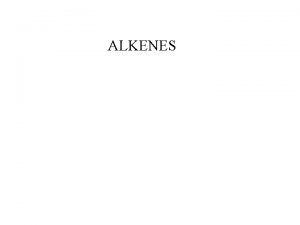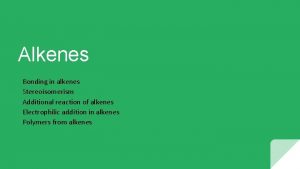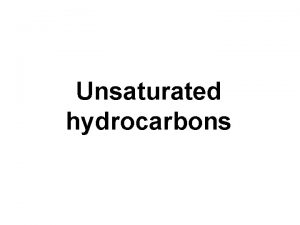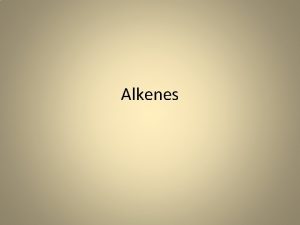Alkanes and Alkenes Contents Alkanes and Alkenes Alkanes









































- Slides: 41

Alkanes and Alkenes

Contents Alkanes and Alkenes Alkanes Combustion of alkanes Alkenes Cracking and polymerization Summary activities

Pure hydrocarbons • • • Because the main use of hydrocarbons is as a fuel there is no point in going to the effort to separate them into individual hydrocarbons. It is, however, possible to obtain pure hydrocarbons by very careful distillation. This section is about pure hydrocarbons.

Organic chemistry: carbon • • • Carbon is an unusual atom in that it is able to form very strong covalent bonds with other carbon atoms. When we then include its ability to also bond with other elements we open up the possibility of the highly diverse and complex molecules (like DNA) that have led to the possibility of life. Because of this, the chemistry of carbon containing compounds is often called organic chemistry.

Alkanes • • The simplest hydrocarbons form a series of compounds known as alkanes. These all consist of carbon and hydrogen only and every carbon has four single covalent bonds. Hydrocarbon Formula Methane CH 4 Ethane C 2 H 6 Propane C 3 H 8 Butane C 4 H 10 Structure hydrogen carbon

Names of alkanes • • The names of the 4 simplest alkanes are methane, propane and butane. After that the names are systematic (like the words used to describe geometric shapes). E. g. 5 carbons = pentane 6 carbons = hexane 7 carbons = heptane 8 carbons = octane 9 carbons = nonane 10 carbons = decane hydrogen carbon C 5 H 12 C 6 H 14 C 7 H 16 C 8 H 18 C 9 H 20 C 10 H 22 pentane

Structure of alkanes • • • Alkanes all have very similar structures. They all consist of carbon and hydrogen only and every carbon has four single covalent bonds. They have a CH 3 at each end of the molecule. What differs is the number of CH 2 groups between the two ends. It is possible to build up a series by simply adding an extra CH 2 group This leads to a general formula of Cn. H 2 n+2 n= 1 hydrogen carbon n=2 n=3 n=4

What’s the formula? • What will be the formula for alkanes containing the following numbers of carbons? Number of carbons Formula 12 C 12 H 26 16 C 16 H 34 31 C 31 H 64 19 C 19 H 40

Formulae and models of alkanes • • • Although normal chemical formula - like C 5 H 12 are used to describe alkanes, they do not convey which atom is joined to which other atom. To get around this we often used displayed formulae to describe organic molecules. Displayed formulae show which 4 atoms each carbon is bonded to, but even these do not show the actual 3 D shapes. For that we use models. H methane, CH 4 H C H H

Formulae and models of alkanes H H C H methane, CH 4 H H H C C H H ethane, C 2 H 6 H H C C C H H propane, C 3 H 8

Formulae and models of alkanes butane, C 4 H 10 H H H C C H H H pentane, C 5 H 12 H H H C C C H H H

Formulae and models of alkanes hexane, C 6 H 14 H H H H C C C H H H H Notice the carbon chain is not really straight and so on…………

Isomerism Alkanes of the same formula can have different arrangements of atoms. Such different arrangements are known as isomers. Two isomers of C 4 H 10 are shown: Isomers of butane

Bonding in alkanes: methane Alkanes contain atoms held together by single covalent bonds. In the displayed formula we show these bonds as a single line. Each line is really a pair of shared electrons. H H C H H H

Bonding in alkanes: ethane • Ethane is the simplest alkane containing a C-C single covalent bond. H H H C C H H H

Bonding in alkanes: propane • Complete the diagram below including its electrons. Carbon electron H Hydrogen electron H H H C C C H H

Combustion of alkanes • Alkanes are not especially reactive but they do undergo one very important reaction: combustion. • With an adequate supply of air they react to form carbon dioxide and water. methane + oxygen water CH 4 + 2 O 2 2 H 2 O + carbon dioxide + CO 2

Incomplete combustion of alkanes • In the absence of an adequate supply of air, alkanes may react to form carbon monoxide and water. • Carbon monoxide is highly poisonous and this is one reason why gas boilers must be serviced regularly. methane + oxygen water 2 CH 4 + 3 O 2 A carbon monoxide detector + carbon monoxide 4 H 2 O + 2 CO

Complete the equation • Complete the equations below assuming an adequate supply of oxygen for complete combustion. (These are quite tricky!) 1. 1. 2 C 22 H H 66 2. 2. C 33 H H 88 7 O ++ 7 O 2 2 ++ 5 O 5 O 22 3. 2 C 13 O 22 4 H 1010 + + 13 O 4 H 4 CO 2 + 6 H 2 O 3 CO 2 + 4 H 2 O 8 CO 2 + 10 H 2 O

Alkenes • When carbon forms compounds each carbon atom always forms four bonds. • This does not, however, mean that each carbon is joined to four other atoms. • It is possible to have bonds grouped into pairs. These are called double bonds. • Alkenes contain carbon atoms joined by double covalent bonds. Single covalent bond C C Double covalent bond C C

Structure of alkenes • A series of alkanes exist, differing only in the number of CH 2 groups. • The same is true for alkenes. • This leads to a homologous series with the general formula Cn. H 2 n. Alkenes hydrogen carbon n= 1 n=2 none = n=3 = n=4 =

What’s the formula? • What will be the formula for alkenes containing the following numbers of carbons? Number of carbons Formula 11 C 11 H 22 13 C 13 H 26 32 C 32 H 64 21 C 21 H 42

The formula of ethene • The simplest alkene is ethene. • It has the formula C 2 H 4 • The carbon atoms are joined together by a double bond. • Its displayed formula may be drawn in slightly different forms but should always clearly show the double bond. H H C C H H or

The electron structure of ethene • In all alkenes there are two carbon atoms that are joined by two pairs of electrons. • This is the double bond. H H C C H H

The structure of pentene • Displayed formula for propene and butene are shown. • Draw a displayed structure for pentene. H H H C C C H H H C H C H H C C H H H

Saturated or unsaturated? • Saturated means “full up”. • Alkanes are saturated • Every carbon atom has already used all four of its bonds to join to four other atoms. No other atoms can be added. • Alkenes are unsaturated • They have a double bond that could instead become two single bonds. This means that other atoms can be added. It is not “full up”.

Testing for alkanes and alkenes • Alkenes are unsaturated and so extra atoms can be added to alkene molecules. • This forms the basis of a test to distinguish between alkanes and alkenes. • When bromine water is added to an alkane nothing happens, but when bromine is added to an alkene the red colour of the bromine disappears. + Bromine loses this red colour gas Br 2 red colourless

Identify the compound • Copy the table and complete the empty boxes. Number of carbons Name Alkane or alkene Formula 5 pentene alkene C 5 H 10 8 octane alkane C 8 H 18 4 butene alkene C 4 H 8 10 decane alkane C 10 H 22

Contents Alkanes and Alkenes Cracking and polymerization

Source of alkenes • Crude oil contains many large molecules. • If these are to be used as fuels or feedstock for the chemical industry then they have to be broken down (or cracked) into smaller molecules. Small molecules Big molecules Medium molecules

Catalytic cracking • Large hydrocarbons are broken down into smaller molecules using heat and a catalyst. • This process is known as catalytic cracking. • The small molecules produced are then separated by distillation. pressure Big molecules Heat to vaporize Catalytic cracker Molecules break up Smaller molecules Distillation tower

Catalytic cracking • In the catalytic cracker long chain molecules are split apart or ‘cracked’. An example of such a reaction is: octane hexane heat & pressure catalyst + Used as a fuel C 8 H 18 C 6 H 14 + C 2 H 4 ethene Used to make plastics

Cracking decane • Draw out displayed formulae of a pair of products formed by cracking decane. H H H C C C C C H H Heat & pressure catalyst H H H H H C C C C H H H H H octane decane + ethene

Making polymers • How do monomers become polymers?

Production of polythene • One important reaction of alkenes involves the joining together of alkene molecules. H H H C C C C C H H H H H 1 2 3 4 5 And lots more. . . thousands This is called addition polymerization and is written as: poly(e)thene pressure n ethene high temperature catalyst n

Polypropene • Ethene is only one alkene. Other unsaturated molecules such as propene, vinyl chloride and styrene can also be polymerized to produce a range of plastics. E. g. propene: poly(propene) n n propene

PTFE • Tetrafluoroethene is another alkene that is made into an important plastic used to coat non-stick pans: polytetrafluoroethene or PTFE. n n tetrafluoroethene poly(tetrafluoroethene) or PTFE

Polymerization of vinyl chloride • Fill in the products that will be obtained from vinyl chloride n H H Cl C C H Vinyl chloride H Cl C C H H pvc n

Uses of plastics Poly(e)thene Polypropene Polystyrene Shopping bags Milk crates Packing Bottles Rope Insulation Buckets Carpet fibres Ball pens Washing-up bowls

Alkanes and Alkenes Summary activities

Glossary l alkanes – A family of saturated hydrocarbons used as fuels. l alkenes – A family of unsaturated hydrocarbons containing l l l one double bond, and which are used to make plastics. cracking – The process in which large molecules are broken down into smaller molecules by heating. monomer – A molecule that joins with others to form a polymerization – The process in which small molecules are joined together to form a much larger molecule. saturated – A molecule in which all the bonds are single. unsaturated – A molecule in which at least one bond is double or triple.
 Alkanes alkenes alkynes
Alkanes alkenes alkynes Diol formation from alkene
Diol formation from alkene Gauche conformation
Gauche conformation Addition polymerisation animation
Addition polymerisation animation But-2-ene polymer
But-2-ene polymer Cycloalkanes
Cycloalkanes Chemsheets reactions of alkenes 2 answers
Chemsheets reactions of alkenes 2 answers Syn addition
Syn addition Addition of halogens to alkenes
Addition of halogens to alkenes Halogenation of alkenes
Halogenation of alkenes Properties of alkenes
Properties of alkenes General formula of alkene
General formula of alkene Sp2 hybridization in alkenes
Sp2 hybridization in alkenes Name the following alkene:
Name the following alkene: Naming alkenes
Naming alkenes Bromine water test
Bromine water test But-1-ene
But-1-ene Ozonolysis
Ozonolysis Alkenes introduction
Alkenes introduction Alkanes solubility
Alkanes solubility Saturated bond
Saturated bond Uses of alkanes
Uses of alkanes Alkanes list
Alkanes list General formula for alkyl group
General formula for alkyl group 3-butyl-3-propyl-1-pentyne
3-butyl-3-propyl-1-pentyne Ir spectrum of alkanes
Ir spectrum of alkanes Combustion of alkynes
Combustion of alkynes Alkane complete combustion
Alkane complete combustion Alkanes def
Alkanes def Alkylation of alkanes
Alkylation of alkanes Viscosity of alkanes
Viscosity of alkanes Cyclopentane uses
Cyclopentane uses Sources of alkanes
Sources of alkanes Cn functional group
Cn functional group General formula of alkanes
General formula of alkanes Chemisty
Chemisty Cause and effect contents of the dead man's pocket
Cause and effect contents of the dead man's pocket Mediastinum anatomy
Mediastinum anatomy Outlining and organizing the speech contents
Outlining and organizing the speech contents Elagse
Elagse Introduction for portfolio
Introduction for portfolio Deep perineal pouch contents
Deep perineal pouch contents
